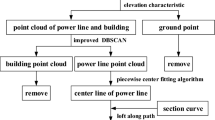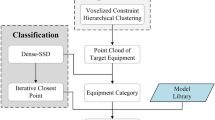Abstract
The point cloud segmentation of a substation device attached with cables is the basis of substation identification and reconstruction. However, it is limited by a number of factors including the huge amount of point cloud data of a substation device, irregular shape, unclear feature distinction due to the auxiliary point cloud data attached to the main body of a device. Therefore, the segmentation efficiency of a substation device is very low. In order to improve the accuracy and efficiency of the point cloud segmentation, this paper proposes a method to segment the attached cables point cloud of a substation device by using the shape feature of point cloud. Firstly, according to the spatial position of the point cloud of a substation device, octree is used to conduct voxelization of the point cloud, and the point cloud resampling is operated according to point cloud density of each voxel, so as to reduce original point cloud data and improve computing efficiency. Then Mean Shift algorithm is used to locate the center axis of the point cloud, and cylinder growth method is used to initially segment cables data and locate the end of each cable. Finally, points of the end are used as seed points to carry out a region growth based on shape feature of the point cloud to realize effective segmentation of cables data. In the experiment, 303 sets of point cloud of devices are selected, including circuit breaker, voltage transformer, transformer, etc. The final result shows that the successful segmentation rate of this method reaches 95.34%, which effectively proves the feasibility of this method.


















Similar content being viewed by others
References
Sipiran, I., Bustos, B., Schreck, T.: Data-aware 3D partitioning for generic shape retrieval. Comput. Graph. 37(5), 460–472 (2013)
Jiang, X.Y., Meier, U., Bunke, H.: Fast range image segmentation using high-level segmentation primitives. In: Proceeding. Third IEEE Workshop on Applications of Computer Vision. WACV'96, pp. 83–88 (1996).
Sappa, A.D., Devy, M.: Fast range image segmentation by an edge detection strategy. In: Proceedings Third International Conference on 3-D Digital Imaging and Modeling, pp. 292–299 (2001)
Besl, P.J., Jain, R.C.: Segmentation through variable-order surface fitting. IEEE Trans. Pattern Anal. Mach. Intell. 10(2), 167–192 (1988)
Yang, L., Zhai, R.: Segmentation of plant organs point clouds through super voxel-based region growing methodology. Comput. Eng. Appl. 55(16), 197–203 (2019)
Vo, A.V., et al.: Octree-based region growing for point cloud segmentation. ISPRS J. Photogramm. Remote. Sens. 104, 88–100 (2015)
Ning, X., Zhang, X., Wang, Y., Jaeger, M.: Segmentation of architecture shape information from 3D point cloud. In: Proceedings of the 8th International Conference on Virtual Reality Continuum and Its Applications in Industry, pp. 127–32 (2009)
Zhang, J., Zhuheng, Lu.: Detection and recognition of pipeline point cloud based on feedback Hough transform. Comput. Modernization 08, 6–11 (2019)
Han, T.: Extraction of LiDAR dome houses based on Hough transform. Sci. Technol. 2016;26(10):122–125+146
Lan, J.: Research and Implementation of Real-Time Plane Detection Algorithms in LiDAR Point Clouds. North China University of Technology, Beijing (2019)
Rethage, D., Wald, J., Sturm, J., et al.: Fully-convolutional point networks for large-scale point clouds. In: 2018 European Conference on Computer Vision, pp. 625–640. Springer, Munich (2018).
Charles, R.Q., Hao, S., Kaichun, M., et al.: PointNet: deep learning on point sets for 3D classification and segmentation. In: 2017 IEEE Conference on Computer and Pattern Recognition, pp. 77–85 (2017). IEEE, Honolulu
Qi, C., Li, Y., Su, H., Guibas, L.: PointNet : Deep Hierarchical Feature Learning on Point Sets in a Metric Space. ArXiv.org (2017)
Xiaochao, W., Xiuping, L., Baojun, Li., Shaoguang, Z.: Feature detection on point cloud via local reconstruction. J. Comput.-Aided Des. Comput. Graph. 25(05), 659–665 (2013)
Min, L., Yun, M.: Study on point cloud management strategy based on Octree-like index. Laser & Optoelectronics Progress, pp. 1–17 [2020-10-29].
Yubing, W.: Scattered point cloud data compression based on octree coding. Eng. J. Wuhan Univ. 53(08), 734–739 (2020)
Kang, Yi., Yuting, Z., Jian, P.: Implementation of 3D object classification algorithm based on the octree representation. Telecommun. Inf. 04, 38–41 (2019)
Lyu, H., Fu, J., Wang, H., et al.: Fast retrieval method of three-dimensional indoor map data based on octree. J. Comput. Appl. 39(01), 82–86 (2019)
Sun H., Sun X., Li H.: 3D point cloud model segmentation based on K-means cluster analysis. Comput. Eng. Appl. 42(10), 42–45 (2006)
Achanta, R., Shaji, A., Smith, K., et al.: SLIC superpixels compared to state-of-the-art super pixel methods. IEEE Trans Pattern Anal. Mach. Intell. 34(11), 2274–2282 (2012)
Demantké, J., Mallet, C., David, N., et al.: Dimensionality based scale selection in 3D LIDAR point clouds. ISPRS Int. Arch. Photogramm. Remote Sens. Spatial Inf. Sci. 38(5), 97–102 (2012)
Martin, E., Hans-Peter, K., Jörg, S., et al.: Adensity-based algorithm for discovering clusters in large spatial databases with noise. In: Proceedings of the Second International Conference on Knowledge Discovery and Data Mining (KDD-96), pp. 226–231. AAAI Press. CiteSeerX 10.1.1.121.9220. ISBN 1-57735-004-9
Fawcett, T.: An introduction to ROC analysis. Pattern Recogn. Lett. 27(8), 861–874 (2006)
Wang, P.: Research on Segmentation Algorithm of Auxiliary Facilities of Substation Equipment Based on 3D Point Cloud. [Master's thesis]. Zhengzhou University, Zhengzhou (2019)
Arastounia, M., Lichti, D.D.: Automatic object extraction from electrical substation point clouds. Remote Sens. 7(11), 15605–15629 (2015)
Acknowledgements
This work was supported by National Natural Science Funds of China (62173309).
Author information
Authors and Affiliations
Corresponding author
Additional information
Publisher's Note
Springer Nature remains neutral with regard to jurisdictional claims in published maps and institutional affiliations.
Rights and permissions
Springer Nature or its licensor (e.g. a society or other partner) holds exclusive rights to this article under a publishing agreement with the author(s) or other rightsholder(s); author self-archiving of the accepted manuscript version of this article is solely governed by the terms of such publishing agreement and applicable law.
About this article
Cite this article
Yuan, Q., Chang, J., Luo, Y. et al. Automatic cables segmentation from a substation device based on 3D point cloud. Machine Vision and Applications 34, 9 (2023). https://doi.org/10.1007/s00138-022-01358-y
Received:
Revised:
Accepted:
Published:
DOI: https://doi.org/10.1007/s00138-022-01358-y




